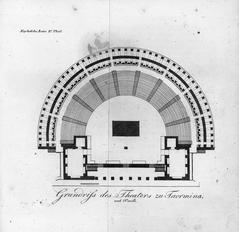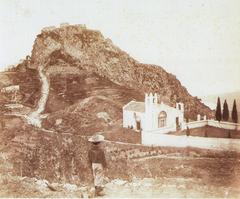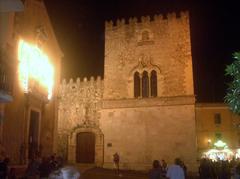Naumachie Taormina, Italy: Complete Visiting Hours, Tickets, and Travel Guide
Date: 14/06/2025
Introduction
The Naumachie of Taormina stands as one of Sicily’s most intriguing Roman monuments. Located in the historic heart of Taormina, this ancient structure is often misunderstood due to its evocative name—derived from the Greek for “naval battle”—yet it is not an arena for aquatic spectacles. Instead, this monumental brick wall and its integrated hydraulic system reveal the sophisticated urban engineering and civic life of Roman Taormina. In this comprehensive guide, you’ll find detailed information on the monument’s history, architecture, cultural significance, visiting hours, ticketing, nearby attractions, accessibility, and practical travel tips.
Table of Contents
- Introduction
- Historical Origins and Etymology
- Construction and Architectural Features
- Function and Civic Role
- Cultural Significance and Urban Context
- Visiting Hours and Ticket Information
- Accessibility
- Nearby Attractions and Walking Routes
- Special Events and Guided Tours
- Photographic Spots and Visitor Tips
- Preservation and Community Value
- Frequently Asked Questions (FAQ)
- Conclusion and Call to Action
- References
Historical Origins and Etymology
The name “Naumachie” comes from the Greek “ναυμαχία” (naumachia), meaning “naval battle.” In antiquity, naumachiae were large-scale, staged naval battles, often performed in specially constructed basins. However, the Taormina Naumachie is not an arena for such events. The misattribution dates to the 18th-century, when scholars mistook its vast reservoir for a flooded performance space (enjoysicilia.it; theworldofsicily.com). Today, it is understood as a monumental retaining wall and nymphaeum, originally part of a Roman gymnasium complex.
Construction and Architectural Features
Structural Layout and Materials
The Naumachie is a striking brick wall approximately 122 meters long and 5 meters high, built against the slope of Monte Tauro in the Giardinazzo district. Archaeological evidence suggests its construction dates to the 1st–2nd centuries AD, during Taormina’s Roman period. The wall rests on a base of local stone blocks, which may be remnants of an earlier Greek stoa—a testament to the city’s layered architectural history (citymapsicilia.it; theworldofsicily.com).
Decorative Elements and Water System
A defining feature of the Naumachie is its alternating sequence of 18 large apsidal (semi-circular) arched niches and an equal number of smaller rectangular niches. The large niches likely housed fountains or water features, while the small ones displayed statues of gods, heroes, or nymphs (taorminawhattodo.com; thatstaormina.com). Behind the wall lies a vast Roman cistern, integral to the city’s water management system. Water from this reservoir supplied public baths, fountains, and possibly irrigated gardens, highlighting Roman expertise in urban hydraulics (traveltaormina.com).
Function and Civic Role
Rather than serving as an entertainment venue, the Naumachie was part of Taormina’s gymnasium—an essential civic institution for physical training, education, and socialization. The water system not only supported the gymnasium’s baths but also provided a vital resource for the town, underscoring the importance of public amenities in Roman urban planning (taormina.it).
Cultural Significance and Urban Context
The Naumachie’s architectural blend of Greek and Roman elements reflects Taormina’s evolution from its Greek foundation to Roman prominence. Its location, near the ancient Forum (now Piazza Vittorio Emanuele) and the renowned Greek Theatre, marks it as a central part of the town’s civic core. The wall’s decorative fountains and statuary would have created a vibrant public gathering space, embodying the aesthetic and social ideals of Roman society (explorecity.life; travelingitalian.com).
Visiting Hours and Ticket Information
- Opening Hours: The Naumachie is an open-air monument, freely accessible to the public at all times. For the best experience, visit during daylight hours (typically 9:00 AM to sunset).
- Tickets: No entrance fee or ticket is required. The site is integrated into the urban fabric, making it an easy and cost-free stop on any Taormina itinerary (enjoysicilia.it; theorangebackpack.nl).
Accessibility
The Naumachie is located on Via Naumachia, just off Corso Umberto I, and is accessible via a level side street. While most visitors, including those with limited mobility, can reach the site, some surrounding streets are cobblestoned and there are occasional steps in the old town. There are no dedicated restrooms or visitor facilities at the monument itself, but amenities are available nearby (theorangebackpack.nl).
Nearby Attractions and Recommended Walking Routes
- Teatro Antico di Taormina: The ancient Greek theatre, offering panoramic views and regular performances.
- Piazza IX Aprile: The town’s main square, renowned for its lively atmosphere and stunning vistas.
- Villa Comunale: Lush public gardens ideal for a relaxing stroll.
- Via degli Artisti: A vibrant street filled with galleries and artisan shops, adjacent to the Naumachie (theorangebackpack.nl).
A suggested walking tour could start at the Greek Theatre, proceed to the Naumachie, and continue along Corso Umberto I.
Special Events and Guided Tours
While the Naumachie does not host dedicated events, it is often included in guided walking tours of Taormina, which provide greater historical context. Local tour operators and the Taormina visitor center can advise on schedules and bookings (Sicily Active).
Photographic Spots and Visitor Tips
- Best Time to Visit: Early morning or late afternoon for softer lighting and fewer crowds.
- Photography: The interplay of sunlight and shadow on the niches makes for striking images.
- Etiquette: Respect the ancient structure—do not climb or leave litter, and follow posted guidelines.
Preservation and Community Value
The Naumachie is protected under Italian cultural heritage law and maintained by local authorities. It features in educational programs and guided tours, ensuring ongoing appreciation and preservation of Taormina’s Roman legacy (enjoysicilia.it).
Frequently Asked Questions (FAQ)
Q: What are the Naumachie visiting hours?
A: The site is open 24/7 as an open-air monument but is best visited during daylight.
Q: Is a ticket required to visit?
A: No, the Naumachie is free to access.
Q: How do I get there?
A: It is located on Via Naumachia, near Corso Umberto I, within walking distance of most major sites.
Q: Are guided tours available?
A: Yes, many local walking tours include the Naumachie.
Q: Is it accessible for those with limited mobility?
A: The site is on a level street, but some surrounding areas have cobblestones and steps.
Q: Can I take photos?
A: Yes, photography is encouraged.
Conclusion and Call to Action
The Naumachie of Taormina is a testament to Roman engineering brilliance and the city’s rich, multicultural heritage. Freely accessible and centrally located, it’s a must-visit for anyone interested in ancient history, architecture, or the unique atmosphere of Taormina. Enhance your visit by exploring nearby sites, joining a guided tour, and capturing memorable photos.
Ready to explore more? Download the Audiala app for guided tours, follow us on social media for the latest updates, and browse our related articles for more inspiration on Taormina and Sicily’s treasures!
References
- taormina.it – What to See in Taormina
- The World of Sicily – Naumachia of Taormina
- Enjoy Sicilia – Naumachia di Taormina
- The Orange Backpack – Best Things to Do in Taormina
- Travel Taormina – Naumachie Taormina
- Taormina What To Do – Naumachia
- Explore City Life – Taormina
- Traveling Italian – Taormina Travel Guide
- Sicily Active – Insiders Guide Taormina



